A place for me to explore the beauty of God's creation, slow down enough to make space for God in my life every day, and bring some rest and inspiration to travellers who stop by. All work here is copyright Rosie Perera. You may only download it to temporary files to view in your browser.
My camera is a Canon EOS 5D.
22 December 2006
Christmas hiatus
Telus didn't get my phone/Internet service connected today as promised, and I'm off for a week for Christmas, so I will resume posting when I get back.
17 December 2006
Neighborhood glow
.jpg) I've been influenced lately by Paul Butzi's photographs of the ordinary in the Snoqualmie Valley where he lives. I am trying to do a bit of what he does, to develop my eye. This is the view out my back window in my new house, taken at dusk. I look out on a rather unattractive alley, with telephone lines, dumpsters, the backs of the buildings on the main business drag one street over from me. And yet, some people have made this lane their home, and have made it look welcoming. And there's also the tip of a snow-capped mountain just peeking over the rooftops towards the left of the photo. I didn't edit out the telephone wires, as I could have easily with Photoshop. I wanted to show the realness of the scene, and how there can be a sense of warmth and comfort in the midst of what one might otherwise write off as ugly.
I've been influenced lately by Paul Butzi's photographs of the ordinary in the Snoqualmie Valley where he lives. I am trying to do a bit of what he does, to develop my eye. This is the view out my back window in my new house, taken at dusk. I look out on a rather unattractive alley, with telephone lines, dumpsters, the backs of the buildings on the main business drag one street over from me. And yet, some people have made this lane their home, and have made it look welcoming. And there's also the tip of a snow-capped mountain just peeking over the rooftops towards the left of the photo. I didn't edit out the telephone wires, as I could have easily with Photoshop. I wanted to show the realness of the scene, and how there can be a sense of warmth and comfort in the midst of what one might otherwise write off as ugly.I like this photo for a couple of other reasons. First, the colors. Orange and blue are opposites on the color wheel, and their contrast is pleasing in a photograph or painting. Second, the composition. The central point of interest (the warm welcoming glow of someone's front entry way) is at one of the "Rule of Thirds" intersection points, and the "cross" of my window gives it some context. I could also give some trite theological interpretation of it, about how the cross puts a seal of God's blessing on the scene, as if to say "yes, Christ died even for these back alley dwellers." But I will refrain. :-) I don't like gratuitous theologizing.
No guesses on the mystery photo from Wednesday yet, so I won't give the answer yet. I don't have Internet access in my new house yet, and won't until Dec 21, so I'm limited to Internet cafes for the time being. I probably won't post again until I'm online at home.
13 December 2006
Mystery photo #2
.jpg) Another abstract one. No special Photoshop effects; this is really what the image looked like on camera (though I did crop it). Post your guesses in the comments, as to what it might be or how I made it. I might be a bit slow on posting the answer, as today is moving day, and my computer is getting packed up in a box momentarily. But it will probably be one of the first things I unpack!
Another abstract one. No special Photoshop effects; this is really what the image looked like on camera (though I did crop it). Post your guesses in the comments, as to what it might be or how I made it. I might be a bit slow on posting the answer, as today is moving day, and my computer is getting packed up in a box momentarily. But it will probably be one of the first things I unpack!
12 December 2006
Olympic mullein (verbascum olympicum)
.jpg) Another close-up from that same day of shooting at Van Dusen Botanical Garden as yesterday's photo. This one demonstrates a compositional technique I like to use to make a photo more interesting. Most aspiring photographers already know that you don't just show the full subject dead-center in the frame. That's boring. The Rule of Thirds helps. But if it's a simple subject like one leaf, even that wouldn't quite give it the punch it needs. Framing it such that part of the object is cut out of the frame can be the difference between ho-hum and mmmm!!!
Another close-up from that same day of shooting at Van Dusen Botanical Garden as yesterday's photo. This one demonstrates a compositional technique I like to use to make a photo more interesting. Most aspiring photographers already know that you don't just show the full subject dead-center in the frame. That's boring. The Rule of Thirds helps. But if it's a simple subject like one leaf, even that wouldn't quite give it the punch it needs. Framing it such that part of the object is cut out of the frame can be the difference between ho-hum and mmmm!!!You might have noticed by now that I vary where I place the photo in relation to the surrounding text. My choice of layout is not random. I base it on the subject of the photo. For example yesterday's flowers were sort of "looking" towards the right, so I put them on the left of the text. Today's leaf is inviting you to think of what is outside the frame on the left, so I put it on the right of the text.
11 December 2006
Balloon flower (platycodon grandiflorum)
.jpg) Just another pretty flower picture today. (From my archives, obviously. Spring does come early in Vancouver, but not this early.)
Just another pretty flower picture today. (From my archives, obviously. Spring does come early in Vancouver, but not this early.)There are some photographers who consider themselves to have "moved beyond the pretty picture" (see, for example, The Landscapist blog). While I am learning to use my photography to communicate (an idea or emotion), to reveal a subject in a new way, or to accomplish something (raising awareness and money for nature conservation, for example), I don't see how I could ever abandon photos that "merely" showcase the beauty of God's creation. It is still a challenge to make them good. And people never tire of looking at them.
This gem was growing at Van Dusen Botanical Garden in Vancouver. I shot it back in 2002 on my old Yashica 230-AF, using color slide film: Fujichrome Velvia 50, known for its saturated colors and ultra-fine grain. I used both a macro filter and a warming filter, and a mini-tripod if I recall. I remember having to lie down on the ground and mess around with the tripod and camera and a reflector for quite a while to get the composition and lighting right. Scanned at 300dpi and touched up dust spots in Photoshop afterwards.
10 December 2006
Funny signs
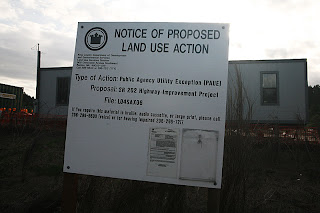.jpg)
Another of my favorite categories of photos is funny signs. I've been collecting them for years, and someday maybe I'll have enough for a book of them. Here's one I saw at a construction site near my house. Notice how enormous the sign is and how big the lettering? Now notice the small print at the bottom, which I've enlarged for you to see:
.jpg)
If you still can't read it (or this blog) and require this material in braille, audio cassette, or large print, please email me.

09 December 2006
Photographing art
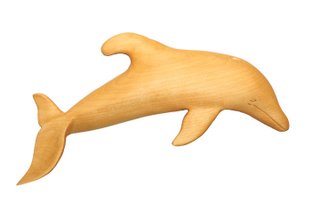 Here's a photo I took recently of a wood carving I did last year of a dolphin. I used it to learn how to remove the background of an image in Photoshop -- a very useful technique which I applied to the safety pins in my "Safety in Numbers" photo. It was much trickier in that image, because of all the tiny places with background showing through between the metal bits.
Here's a photo I took recently of a wood carving I did last year of a dolphin. I used it to learn how to remove the background of an image in Photoshop -- a very useful technique which I applied to the safety pins in my "Safety in Numbers" photo. It was much trickier in that image, because of all the tiny places with background showing through between the metal bits.One has to be careful in claiming artistic ownership of a photograph of another work of art (unless it shows that work in a new and creative way). I love photographing stained glass windows, for example, but mostly only as a document of what I've seen, since the real artist was the stained glass worker. In this case, though, since I was the artist who created the wood carving, I'm not plagiarizing. But it remains only a documentary photo, not a work of art in its own right.
Still, photographs of art, when authorized, can be a great way of making that art accessible to others. Thank goodness for good quality photographic reproductions of museum art all over the world, which otherwise would be available only to those who could afford to travel to Paris, London, Berlin, etc. My friend Bruce Jeffrey, a professional photographer in Vancouver, has done some stunning photos of the frescoes and sculptures of Benedictine monk Father Dunstan Massey, most of which are hidden away in the monks' private quarters in Westminster Abbey, in Mission, BC. The general public never gets to see this stuff, but it is amazing work. And Bruce's high quality reproductions allowed it to come out of the cloister and into the art gallery.
08 December 2006
Mystery revealed
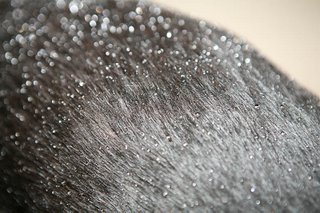 The answer to the first mystery photo is snowflakes on my dog's back. Here is the original photo. I cropped it to the out-of-focus section in the upper left, which I thought made an interesting pattern, and was suitably mysterious. Sometimes throwing subjects way out of focus intentionally can be a useful artistic device.
The answer to the first mystery photo is snowflakes on my dog's back. Here is the original photo. I cropped it to the out-of-focus section in the upper left, which I thought made an interesting pattern, and was suitably mysterious. Sometimes throwing subjects way out of focus intentionally can be a useful artistic device.Also, this rather boring original photo shows you that you can often find a hidden gem even in a throw-away shot, so don't throw any of them away until you've given them a closer look. When I first got my digital camera, I used to delete bad shots right on my camera as soon as I took them. But I read somewhere someone's philosophy that the record of digital photos you've taken should be no different than the strips of negatives we used to keep all of, even if only a few of the shots were worth printing. With a 1.5 terabyte hard disk, and cheap optical archival media (double-sided DVDs), I have no need to weed. So now I keep virtually all of my original digital images. I'll only ditch the really bad mistakes (e.g., a lovely picture of the inside of my lens cap) when there's obviously no material for mining of art.
A bird in the bush is worth...
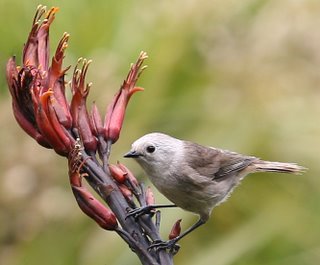 Back to some nature & wildlife photography. This is a photo I took in New Zealand last year. It's a whitehead (Maori: popokatea), one of the protected species of birds on Tiritiri Matangi Island, a 220-hectare nature reserve with some of the best birdwatching in all of New Zealand, and of anywhere I've been in the world (I'm relatively new at birdwatching, though).
Back to some nature & wildlife photography. This is a photo I took in New Zealand last year. It's a whitehead (Maori: popokatea), one of the protected species of birds on Tiritiri Matangi Island, a 220-hectare nature reserve with some of the best birdwatching in all of New Zealand, and of anywhere I've been in the world (I'm relatively new at birdwatching, though).This shot demonstrates how lots of megapixels can compensate for not having as long a lens as one might have wished for with wildlife photography. A 400mm or even 600mm lens would be better for birds, but I'm still saving up for one of these babies. I was shooting with my 70-200mm lens, but I evidently didn't even have time to zoom it all the way out to 200. I shot this at 160mm, wanting to make sure I at least got something before the bird flew away, which indeed he did as soon as I shot it. Miraculously, I was able to focus quickly and get a good image. But I was at least 10-15 feet away from the bird, and he fills up less than 1% of the frame of my original photo. So I had to crop severely to make him fill more of the frame. However, thanks to the 12.8 megapixels of my Canon 5D, I could enlarge that tiny a portion of the photo, and he's still as sharp as can be. I cropped out everything that was not essential, leaving the bit of flax bush that he was perched on. It's quite characteristic of their habitat. At that distance, with that lens, and an aperture of f/5.6, my depth of field was less than a foot. This made for a good separation between subject and out-of-focus background.
I plan to make cards out of this photo and offer them to the gift shop on Tiritiri Matangi to sell, and will donate the proceeds to help with the protection of all these wonderful species of birds. That's one more way where my faith and photography can be integrated. I believe in stewardship of God's creation, and if I can use my art to help with that, what a privilege!
07 December 2006
Don't worry, be happy!
 Today's photo was for an assignment that was given to me: to take a photograph in such a way that it expresses the emotion I was having about the subject. It was a very difficult assignment (you try it!). I spent the afternoon on Granville Island trying to find things to photograph that I had any emotions about whatsoever. There weren't many. My emotions aren't normally triggered that way, it turns out. This was the only halfway decent photo I got out of the assignment, and even it is a little bit cheesy. But cute. And it still makes me smile when I see it. Hope it does you, too.
Today's photo was for an assignment that was given to me: to take a photograph in such a way that it expresses the emotion I was having about the subject. It was a very difficult assignment (you try it!). I spent the afternoon on Granville Island trying to find things to photograph that I had any emotions about whatsoever. There weren't many. My emotions aren't normally triggered that way, it turns out. This was the only halfway decent photo I got out of the assignment, and even it is a little bit cheesy. But cute. And it still makes me smile when I see it. Hope it does you, too.The mystery photo from yesterday is still open for guesses.
06 December 2006
'Tis mystery all...
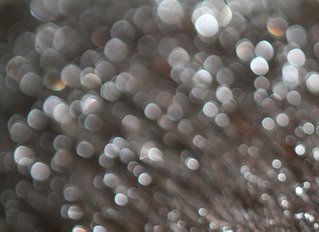 I like Admonit's idea of posting mystery photos here and leaving you all in suspense for a while. So, without further ado, here's one. Please post your guesses in the comments. Maybe this will lure a few of you lurkers out of hiding. I'll report the answer in a few days and will keep score of who gets it right. Hint: this one was taken on November 25.
I like Admonit's idea of posting mystery photos here and leaving you all in suspense for a while. So, without further ado, here's one. Please post your guesses in the comments. Maybe this will lure a few of you lurkers out of hiding. I'll report the answer in a few days and will keep score of who gets it right. Hint: this one was taken on November 25.To post a comment:
1. Click on the "COMMENTS" link below a post.
2. Type in your comment
3. Choose an identity. If you don't have a Blogger account, you can still leave a comment, either as your name or a pseudonym if you prefer -- preferably one that would let me guess who you are but you'd remain in cognito to the wider Internet world. For either of these options, choose "Other" and fill in your name or pseudonym (you can leave your web page blank if you don't have one). I'd rather you not post under the third option, Anonymous, but there's no way in Blogger to disable that option without also disabling people from posting who do not have Blogger accounts. If you do use Anonymous, you can always still sign your post if you like.
4. In the Word Verification box, type in the funny squiggly letters you see in the picture above it. This is to verify that you are a human being, to prevent automated spam from showing up here.
5. If you want to check out how your comment is going to look (good idea if you use any HTML code in it), click Preview and make sure everything comes out OK. Otherwise skip to step 6.
6. Click "Login and Publish" (or if you did Preview first, you can also click "publish this comment")
04 December 2006
Mystery photos
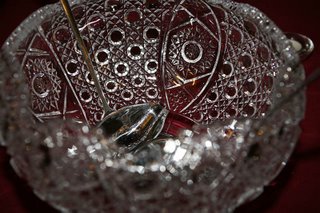 When I was growing up, the local weekly newspaper, The Berkshire Sampler, ran a mystery photo column. You'd try to guess what it was, and they'd announce the winner in the following issue. I always loved those, and am still drawn to that sort of close up photography where it's hard to identify the subject, but the photo is still interesting even if you don't know what it's of. From my memories of that fun challenge, I later developed the game of "mystery photo" which I recently introduced to the children (ages 9 and 11) of some friends of mine, as a way of teaching them about photography. We would take turns going around the house (while the others hid their eyes to the count of 100) and finding something to make a mystery photo of. Then the others would have to try to identify the subject of the photo.
When I was growing up, the local weekly newspaper, The Berkshire Sampler, ran a mystery photo column. You'd try to guess what it was, and they'd announce the winner in the following issue. I always loved those, and am still drawn to that sort of close up photography where it's hard to identify the subject, but the photo is still interesting even if you don't know what it's of. From my memories of that fun challenge, I later developed the game of "mystery photo" which I recently introduced to the children (ages 9 and 11) of some friends of mine, as a way of teaching them about photography. We would take turns going around the house (while the others hid their eyes to the count of 100) and finding something to make a mystery photo of. Then the others would have to try to identify the subject of the photo.I took this photo last night at the Regent College Christmas party. I'm not going to make you spend too long guessing what it is. It's a punch bowl, before it was filled with punch. It was taken with flash, f/4, 1/60 sec, ISO 400. The relatively narrow depth of field allowed me to focus on just the inside of the bowl and the ladle, giving a sort of mysterious haze to the near and far edges of the bowl. The flash gives all kinds of interesting highlights and sparkles on the glass and the silver ladle.
I love the shape of the bowl, how it takes hold of your eye and rolls it around centrifugally bringing it back again and again to the center at the bottom of the bowl, as a marble rolling around inside the bowl might do. I also like the way the wine colored tablecloth shows through the crystal. This is the kind of photograph that I could gaze at for a long time, almost mesmerized. It has deeper implications as well. It is somewhat reminiscent of a goblet, and the wine color together with that cannot but remind me of the cup of communion. The fact that it's a punch bowl at a party in a community I love also calls up warm thoughts of friendship, hospitality, good food/drink, celebration, and Christmas. Finally, it is an appropriate symbol of the mystery of Christ's advent: a womb-shaped bowl waiting expectantly to be filled with its liquid. Talk about Space For God!
01 December 2006
Integration of photography and life
A quote from Bruce Barnbaum, The Art of Photography (emphasis mine):
 I have mostly been reflecting thus far on how photography integrates with my faith. But there are all sorts of other areas of my life that it touches on. I knew this blog couldn't go very long without including my black lab, Cricket, who is a big part of my life. She's also a great subject for photos. We'd just arrived in the parking lot for Cricket's canine water therapy appointment (basically underwater massage and swimming in a heated dogs-only pool; ah, what luxury!). I had brought my camera along to do a photo shoot for Cindy Horsfall for her La Paw Spa website. I happened to have it ready in hand when I turned around and saw Cricket begin to yawn, and I managed to catch her right at the curled tongue stage. I've titled this one "Are We There Yet?"
I have mostly been reflecting thus far on how photography integrates with my faith. But there are all sorts of other areas of my life that it touches on. I knew this blog couldn't go very long without including my black lab, Cricket, who is a big part of my life. She's also a great subject for photos. We'd just arrived in the parking lot for Cricket's canine water therapy appointment (basically underwater massage and swimming in a heated dogs-only pool; ah, what luxury!). I had brought my camera along to do a photo shoot for Cindy Horsfall for her La Paw Spa website. I happened to have it ready in hand when I turned around and saw Cricket begin to yawn, and I managed to catch her right at the curled tongue stage. I've titled this one "Are We There Yet?"
In animal photography, the key is to focus on the eyes. It's not such a big deal if the snout is out of focus, as it adds depth to the photo, especially with a solid colored pet. In this case, Cricket's eyes weren't open anyway, and her tongue was the point of interest, so I focused on that. Incidentally, dogs aren't the only animals who curl their tongues when they yawn. See this award-winning photo by Don Johnson.
I have long felt that most people segregate their lives, putting their work in one place, photography in another, music in a third, other outside interests in a fourth, etc....Art, music, religion, food gathering, birth, marriage and death, are all intertwined. Each represents an essential part of life, and none can exist without support from the others. Why we have evolved into a civilization that segregates these aspects of life into essential and nonessential aspects could be a lifelong study for teams of anthropologists. But I feel that each of us who are seriously interested in making photographs could benefit greatly by trying to integrate the many facets of our own lives.
 I have mostly been reflecting thus far on how photography integrates with my faith. But there are all sorts of other areas of my life that it touches on. I knew this blog couldn't go very long without including my black lab, Cricket, who is a big part of my life. She's also a great subject for photos. We'd just arrived in the parking lot for Cricket's canine water therapy appointment (basically underwater massage and swimming in a heated dogs-only pool; ah, what luxury!). I had brought my camera along to do a photo shoot for Cindy Horsfall for her La Paw Spa website. I happened to have it ready in hand when I turned around and saw Cricket begin to yawn, and I managed to catch her right at the curled tongue stage. I've titled this one "Are We There Yet?"
I have mostly been reflecting thus far on how photography integrates with my faith. But there are all sorts of other areas of my life that it touches on. I knew this blog couldn't go very long without including my black lab, Cricket, who is a big part of my life. She's also a great subject for photos. We'd just arrived in the parking lot for Cricket's canine water therapy appointment (basically underwater massage and swimming in a heated dogs-only pool; ah, what luxury!). I had brought my camera along to do a photo shoot for Cindy Horsfall for her La Paw Spa website. I happened to have it ready in hand when I turned around and saw Cricket begin to yawn, and I managed to catch her right at the curled tongue stage. I've titled this one "Are We There Yet?"In animal photography, the key is to focus on the eyes. It's not such a big deal if the snout is out of focus, as it adds depth to the photo, especially with a solid colored pet. In this case, Cricket's eyes weren't open anyway, and her tongue was the point of interest, so I focused on that. Incidentally, dogs aren't the only animals who curl their tongues when they yawn. See this award-winning photo by Don Johnson.
30 November 2006
The faith of a child
 I witnessed this scene in the Loretto Chapel in Santa Fe (more famous for its miraculous staircase than its statuary). I was struck by the boy's rapt gaze at Jesus, oblivious to the major tourist attraction. "Unless ye become as a little child...." My photos of the staircase were interesting, but nothing like this. Sometimes if you take your eye off what everyone else is looking at, you'll end up capturing the better photograph. It's related to a well known strategy of some photojournalists: rather than pointing the camera at the spectacle, focus on the people watching the spectacle, and you'll get some wonderful shots like this one by famous photojournalist Harry Benson, of Coretta Scott King and her children watching her husband's funeral procession.
I witnessed this scene in the Loretto Chapel in Santa Fe (more famous for its miraculous staircase than its statuary). I was struck by the boy's rapt gaze at Jesus, oblivious to the major tourist attraction. "Unless ye become as a little child...." My photos of the staircase were interesting, but nothing like this. Sometimes if you take your eye off what everyone else is looking at, you'll end up capturing the better photograph. It's related to a well known strategy of some photojournalists: rather than pointing the camera at the spectacle, focus on the people watching the spectacle, and you'll get some wonderful shots like this one by famous photojournalist Harry Benson, of Coretta Scott King and her children watching her husband's funeral procession.I should point out that I asked the boy's mother for permission to photograph her son. And, in fact, I asked his permission, too. I hadn't been quick enough with my camera when I first saw the scene, and he moved away. But I asked him if he'd go back and stand there gazing at Jesus as he had been before, and he obliged. So it's a staged photo, but it's exactly what it would have looked like if it hadn't been staged. This relates to my post from a couple of days ago on Iambic Admonit about photographing vs. taking photos. While it might have been more natural to take the photo before the boy knew he was being photographed, I'm at least glad that I got to speak to him and his mother about it, and they were pleased to cooperate. I would have felt equally fine about the photo from an ethical standpoint if I'd gotten the permission after I tripped the shutter, and sometimes that's what you've got to do. I'm also not opposed to intentionally (and even mischievously) setting up situations that will result in a great candid photo, such as this one by Harry Benson.
28 November 2006
Winter Wonderland
 The storm from a couple of days ago continued and broke a 50-year-old record for snowfall this early in the season. Here's my street. This photo makes use of the element of line, which is important in composition. Also, the vanishing point is on one of the imaginary vertical lines dividing the photo into thirds. I experimented with flipping the photo to make the diagonal line go from lower left to upper right, generally a stronger composition leading the viewer's eye into the photo (because we Westerners are used to reading from left to right), but (a) it looked awkward to me because it's not how my street looks, and (b) there is some sense in having the diagonal go this way, because it creates tension in a photograph, and that is somewhat consistent with how some people might be feeling about having all that snow on the roads. It is still a peaceful scene (undisturbed snow on trees and cars is inherently peaceful), but I wanted to convey that it's more complex than that. These roads are pretty treacherous. They don't plow or put salt on the minor roads in Vancouver.
The storm from a couple of days ago continued and broke a 50-year-old record for snowfall this early in the season. Here's my street. This photo makes use of the element of line, which is important in composition. Also, the vanishing point is on one of the imaginary vertical lines dividing the photo into thirds. I experimented with flipping the photo to make the diagonal line go from lower left to upper right, generally a stronger composition leading the viewer's eye into the photo (because we Westerners are used to reading from left to right), but (a) it looked awkward to me because it's not how my street looks, and (b) there is some sense in having the diagonal go this way, because it creates tension in a photograph, and that is somewhat consistent with how some people might be feeling about having all that snow on the roads. It is still a peaceful scene (undisturbed snow on trees and cars is inherently peaceful), but I wanted to convey that it's more complex than that. These roads are pretty treacherous. They don't plow or put salt on the minor roads in Vancouver.
27 November 2006
Humor in timing
 Here's another of my humorous juxtaposition photos. The timing is everything. I just happened to snap this shot of a statue of William of Orange on "Het Plein" (what an original name for a city square; it means literally "the square") in The Hague, right as a seagull was flying past. I do remember trying to make sure the seagull was in the picture, just for scale, but didn't know how well positioned it was until after I saw the resulting photo. Not only is William pointing to the bird, but his dog is looking up at it, too. It's as if they were out birdwatching together. This is what I was talking about in my comment on my November 22 surreal photo (in the comments section) when I said sometimes it seems as though God has a sense of humor. You could call this photo the result of chance in the timing, but I choose to believe there is divine intentionality behind much of what we call "coincidence."
Here's another of my humorous juxtaposition photos. The timing is everything. I just happened to snap this shot of a statue of William of Orange on "Het Plein" (what an original name for a city square; it means literally "the square") in The Hague, right as a seagull was flying past. I do remember trying to make sure the seagull was in the picture, just for scale, but didn't know how well positioned it was until after I saw the resulting photo. Not only is William pointing to the bird, but his dog is looking up at it, too. It's as if they were out birdwatching together. This is what I was talking about in my comment on my November 22 surreal photo (in the comments section) when I said sometimes it seems as though God has a sense of humor. You could call this photo the result of chance in the timing, but I choose to believe there is divine intentionality behind much of what we call "coincidence."
26 November 2006
First snow of the season
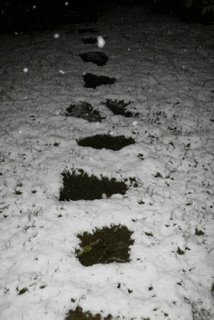 This is more along the lines of the "one photo a day" project I initially thought this blog would be about. I realize I've strayed away from that due to my love of teaching, and my desire to show off my best photos from the past here. A photo a day won't always produce framable wonders. But it is a great form of documentary photography. See my discussion of that on a recent post over at Iambic Admonit, another blog I write for occasionally. Don't worry, I will continue to "stray" into showing off great photos as long as I don't run out of them. But I want to keep doing some new work as well.
This is more along the lines of the "one photo a day" project I initially thought this blog would be about. I realize I've strayed away from that due to my love of teaching, and my desire to show off my best photos from the past here. A photo a day won't always produce framable wonders. But it is a great form of documentary photography. See my discussion of that on a recent post over at Iambic Admonit, another blog I write for occasionally. Don't worry, I will continue to "stray" into showing off great photos as long as I don't run out of them. But I want to keep doing some new work as well.I took this photo last night as the first snow of the season was coming down. It was pitch dark out, but I used flash and was thus able to freeze some of the falling snowflakes in mid-air. The black blotches on the ground are a stone pathway in my back yard. Interesting how the stone holds onto its heat from the day long enough to melt the snow falling on it. This looks black & white, but it is a color photo.
24 November 2006
Bleeding heart detail
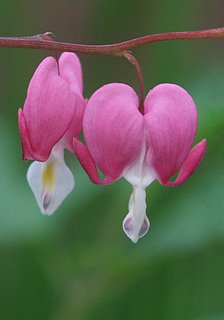 As promised, here's my choice for the best couple of blossoms from yesterday's bleeding heart photo, close cropped (notice the "rule of thirds" at work here), with a bit of Photoshop action on the far right to remove the edge of another blossom that was showing. (I didn't want to simply crop it out because it would have made that edge too close to the subject.) The clone stamp tool and spot healing brush are amazing! With all my talk of Photoshop, I need to emphasize that you've got to begin with a good image and have some skill and a good artistic eye in order to use the software successfully. Photoshop is not the idiot's way to make a bad photograph good.
As promised, here's my choice for the best couple of blossoms from yesterday's bleeding heart photo, close cropped (notice the "rule of thirds" at work here), with a bit of Photoshop action on the far right to remove the edge of another blossom that was showing. (I didn't want to simply crop it out because it would have made that edge too close to the subject.) The clone stamp tool and spot healing brush are amazing! With all my talk of Photoshop, I need to emphasize that you've got to begin with a good image and have some skill and a good artistic eye in order to use the software successfully. Photoshop is not the idiot's way to make a bad photograph good.This is an image I'd consider using for a card, maybe for Valentine's Day, though I'm not sure whether that might give the wrong impression (bleeding heart = broken heart?).
23 November 2006
Bleeding heart
 As I was saying yesterday, I like repeating patterns or shapes. This time it's from nature, in a bleeding heart (Dicentra spectabilis) that I came across on the campus of Seattle Pacific University this past May when I was there for a meeting. You never know when you might see something of such exquisite beauty. So it's always a good idea to bring your camera everywhere.
As I was saying yesterday, I like repeating patterns or shapes. This time it's from nature, in a bleeding heart (Dicentra spectabilis) that I came across on the campus of Seattle Pacific University this past May when I was there for a meeting. You never know when you might see something of such exquisite beauty. So it's always a good idea to bring your camera everywhere.I used a wide aperture, namely f/4, for a narrow depth of field (the smaller the "f-number" the larger the opening and the smaller the depth of field), otherwise known as "selective focus" -- to throw the background out of focus and draw attention to the flowers. Even so, that one leaf at the bottom is too close to the focal plane of the bleeding hearts, so it isn't blurry enough and is a bit of a distraction. Using a blur filter in Photoshop on that section of the image is one solution. But I chose a different one for my final image, which you'll just have to wait until tomorrow to see.
22 November 2006
Experimenting with avant garde photography
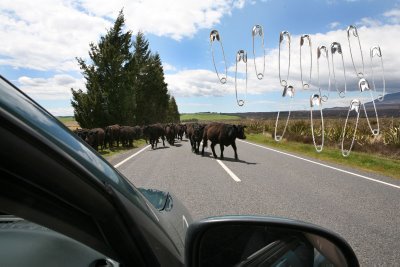 OK, this is really wonky, but I just wanted to try something surreal to see how I liked it. And it was a way to learn another technique in Photoshop.
OK, this is really wonky, but I just wanted to try something surreal to see how I liked it. And it was a way to learn another technique in Photoshop.I don't normally do still lifes, unless the main element is repeated patterns, which the superimposed image qualifies as. I shot this setup of a bunch of safety pins this evening, thinking I might do something interesting with it and then title it "Safety in Numbers." The fun part was selecting just the safety pins and none of the background, turning that into a mask, making the background transparent, thus making the photo mergable into any other photo I chose. But what photo to blend it with? I figured one of another herd of "somethings" that might be seen as attacking the safety pins might do the trick, so I pulled up this one from my trip to New Zealand last fall. Yes, while I was driving down the road (on the left side, you'll notice -- they drive on the "wrong" side of the road down there, to us North Americans), a herd of cattle came right at me and stopped me in my path. I had my camera handy on the passenger's seat next to me, because there were so many things I wanted to stop for and hop out of the car to photograph. This one just had to be done from inside the car, though.
Safety pin silliness aside, the main picture here is another example of one of my favorite genres of photography, which is the humorous justaposition (the "Jesus of the Hoops" from last week was another example). I'm talking about natural juxtaposition, not doctored up in Photoshop. Things I come across which make me laugh, and which I hope bring a smile to the face of the viewer. You'll be seeing more of those here in the coming days. As well as more of my nature shots, etc.
So what's my verdict on whether I like surreal photography? I need more practice if it's going to be successful, and I probably need to study the genre some. It's never been a genre I've appreciated looking at, so why I ever tried it is beyond me. Well, I guess the medium is the message, as Marshall McLuhan said, and Neil Postman latched onto. In other words, a medium shapes what we communicate with it. Because I could do this in Photoshop, I wanted to try. Not necessarily a good reason to keep doing it. I could wax philosophical about technology and whether we should do things just because we can, but I'll stop there. What do you think -- about the photo, surreal art/photography in general, and this philosophical question? I know I've picked up a couple of additional readers lately, so I'd love to hear your comments.
21 November 2006
Sheep in the woods
 I'm back. I promised a photo from Galiano Island. It was pouring pretty much the whole time I was there, so once again this one is from my archives: a couple of the sheep from Hunterston Farm. They graze freely between meadow and forest and are often seen hanging around among the trees. I did some dodging and burning in Photoshop on this one, as the foreground sheep was in shadow. I used this photo for the front cover of our guest book at the cottage.
I'm back. I promised a photo from Galiano Island. It was pouring pretty much the whole time I was there, so once again this one is from my archives: a couple of the sheep from Hunterston Farm. They graze freely between meadow and forest and are often seen hanging around among the trees. I did some dodging and burning in Photoshop on this one, as the foreground sheep was in shadow. I used this photo for the front cover of our guest book at the cottage.
18 November 2006
Partial eclipse, later phase on same night
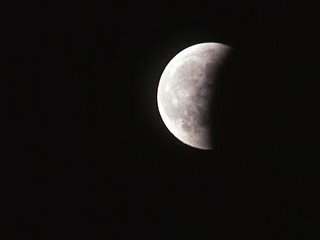 Well, you were probably expecting a close-up of that total eclipse, if you're following my pattern. But I surprised you. This time it's another photo taken on the same night, from the same vantage point, with the moon looking altogether different because it had passed most of the way out of the shadow of the earth by this point. This one was taken at f/1.7 and 1/30 sec.
Well, you were probably expecting a close-up of that total eclipse, if you're following my pattern. But I surprised you. This time it's another photo taken on the same night, from the same vantage point, with the moon looking altogether different because it had passed most of the way out of the shadow of the earth by this point. This one was taken at f/1.7 and 1/30 sec.I'm going to Galiano Island for a couple of days, so no photos until I return on Monday. I might just have a photo from Galiano to post when I get back...
17 November 2006
Total lunar eclipse
 Today it's still pouring out (we've had nasty water conditions in Vancouver because of it -- the reservoirs got contaminated by flooding). So I haven't been out photographing at all and am pulling another image up from the archives. This is the total lunar eclipse that was visible in Western Canada on October 27, 2004. It's the first of the two best images I got that night (if you're picking up on my style by now, you can guess what tomorrow's photo is going to be). This was taken on slide film (Fuji Provia, ISO 400) before I switched to digital. I was shooting a Yashica 230-AF with a Tamron 500mm lens, on a tripod. Exposure was f/1.7 at 1 second.
Today it's still pouring out (we've had nasty water conditions in Vancouver because of it -- the reservoirs got contaminated by flooding). So I haven't been out photographing at all and am pulling another image up from the archives. This is the total lunar eclipse that was visible in Western Canada on October 27, 2004. It's the first of the two best images I got that night (if you're picking up on my style by now, you can guess what tomorrow's photo is going to be). This was taken on slide film (Fuji Provia, ISO 400) before I switched to digital. I was shooting a Yashica 230-AF with a Tamron 500mm lens, on a tripod. Exposure was f/1.7 at 1 second.
16 November 2006
Roadside Jesus Art in New Mexico
 We're departing from the theme of autumn leaves for the time being. Today's photo is one I took on my trip to New Mexico in early August. We just don't get that kind of public piety up here in the Pacific Northwest, apart from a few white cross shrines near the side of the road where people were killed in car accidents. This "Jesus of the Hoops," as I call it, is somewhat tacky at one level, but there's also something beautiful about it. The basketball hoop is like a second halo, echoing the yellow painted halo and the shape of the crown of thorns, which is in turn repeated in the stack of old tires. This is an everyday Jesus. He's there in the midst of the sweltering heat, while you shoot hoops behind the garage, carry a load in your wheelbarrow, work on your beater van with the missing bench seat. And yet he's somehow otherworldly, painted with saintly aspect, eyes averted, blood trickling down his face, shoulders and chest. You probably can't see it in the low-res version of this picture, but the painter signed his work with his initials and the date: "** - 77" (the initials had been blacked out; perhaps he was embarrassed by his work or wanted it to remain anonymous). This isn't art photography per se as much as it is a photograph of art. But I've taken it in an artistic way, framing it to emphasize the jarring juxtaposition of Jesus and junk, and the repeating halo shapes.
We're departing from the theme of autumn leaves for the time being. Today's photo is one I took on my trip to New Mexico in early August. We just don't get that kind of public piety up here in the Pacific Northwest, apart from a few white cross shrines near the side of the road where people were killed in car accidents. This "Jesus of the Hoops," as I call it, is somewhat tacky at one level, but there's also something beautiful about it. The basketball hoop is like a second halo, echoing the yellow painted halo and the shape of the crown of thorns, which is in turn repeated in the stack of old tires. This is an everyday Jesus. He's there in the midst of the sweltering heat, while you shoot hoops behind the garage, carry a load in your wheelbarrow, work on your beater van with the missing bench seat. And yet he's somehow otherworldly, painted with saintly aspect, eyes averted, blood trickling down his face, shoulders and chest. You probably can't see it in the low-res version of this picture, but the painter signed his work with his initials and the date: "** - 77" (the initials had been blacked out; perhaps he was embarrassed by his work or wanted it to remain anonymous). This isn't art photography per se as much as it is a photograph of art. But I've taken it in an artistic way, framing it to emphasize the jarring juxtaposition of Jesus and junk, and the repeating halo shapes.It was a very bright day, so parts of this photo are washed out (overexposed). Nothing Photoshop could do about that. One of these days I'll get on the ball and do some HDR (high dynamic range) photography, where you take two different exposures of the same photo (using a tripod of course, to keep the composition exactly the same), one properly exposed for the shadows and one for the highlights, and then, using some fancy selection and masking and layers work in Photoshop, you merge the shadows of the former with the highlight areas of the latter for a perfectly exposed photo from bright to dark. No camera has the breadth of dynamic range that the human eye has, but with the magic of technology, you can make it look like it does. This process can be quite time consuming, but the results are stunning.
15 November 2006
Leaf pattern detail
 Here's a closer look at those interesting patterns on the leaf from yesterday. One friend suggested they might be some kind of blight or disease, but I'm not so sure. Given the time of year (leaves are turning brown anyway) I think it's probably just that the leaf was dying from the inside out. I did find another one with a similar pattern on the ground the next day. This photo was taken with a +4 diopter macro filter at f/16 and 6 seconds, with a tripod of course. Even so, the edges are a bit blurry. A macro filter is essentially magnifying glass, and it distorts things around the edges. So it's nearly impossible to have the entire image in focus. Unless you crop out the fuzzy bits. Still, I kind of like the dreamy quality to this photo. Again, no color adjustments at all. What a brilliant red-orange leaf!
Here's a closer look at those interesting patterns on the leaf from yesterday. One friend suggested they might be some kind of blight or disease, but I'm not so sure. Given the time of year (leaves are turning brown anyway) I think it's probably just that the leaf was dying from the inside out. I did find another one with a similar pattern on the ground the next day. This photo was taken with a +4 diopter macro filter at f/16 and 6 seconds, with a tripod of course. Even so, the edges are a bit blurry. A macro filter is essentially magnifying glass, and it distorts things around the edges. So it's nearly impossible to have the entire image in focus. Unless you crop out the fuzzy bits. Still, I kind of like the dreamy quality to this photo. Again, no color adjustments at all. What a brilliant red-orange leaf!I have saved the leaf, pressed between two pieces of wax paper under a phone book. That's what the lady at the copy center suggested when I brought it in to them yesterday to have it laminated. She said she'd tried that with a leaf she found, and it rotted. So she recommended that I let it fully dry out before laminating it. I hope it doesn't lose some of its color in the next day or so while it dries.
14 November 2006
Amazing leaf
 Continuing on with the autumn theme, today's photo is one I took yesterday of a leaf (one of the same kind as in my first post, still to be identified) with an incredible pattern of dead brown patches against the red background. I found it on the ground near where I found the other one with the droplets a few days ago. I did not touch up the colors on this photo (other than to remove some distracting glare from the flash on the white background -- I brought the leaf inside to photograph it on a white shelf from my Ikea bookcase). I have never seen anything like this before! I could not stop gazing at it, it's so beautiful and fascinating. One of the things I like about exploring God's creation with my camera is there is no end to the surprises and marvels I discover. But this leaf, small though it may be, is way up there on my all-time list of amazing natural wonders.
Continuing on with the autumn theme, today's photo is one I took yesterday of a leaf (one of the same kind as in my first post, still to be identified) with an incredible pattern of dead brown patches against the red background. I found it on the ground near where I found the other one with the droplets a few days ago. I did not touch up the colors on this photo (other than to remove some distracting glare from the flash on the white background -- I brought the leaf inside to photograph it on a white shelf from my Ikea bookcase). I have never seen anything like this before! I could not stop gazing at it, it's so beautiful and fascinating. One of the things I like about exploring God's creation with my camera is there is no end to the surprises and marvels I discover. But this leaf, small though it may be, is way up there on my all-time list of amazing natural wonders.
13 November 2006
Unidentified moth
 Today's photo is of a moth I saw on my sliding glass door last night. It's taken from inside, so it's the underside of the moth. A good nature photographer should always identify the species of the subject, but I was unable to, even with the use of my loupe to study the moth's markings (yes, the moth allowed me to get that close from the front), and the help of the amazing BugGuide.net.
Today's photo is of a moth I saw on my sliding glass door last night. It's taken from inside, so it's the underside of the moth. A good nature photographer should always identify the species of the subject, but I was unable to, even with the use of my loupe to study the moth's markings (yes, the moth allowed me to get that close from the front), and the help of the amazing BugGuide.net.I took the photo at a focal length of 120mm (on my 70-200 zoom lens) with a +2 macro filter. Because of the difficulty focusing in macro photography, I used a tripod, an aperture of f/10 to maximize depth of field, and ISO 400. I had to underexpose by 2 stops from what my meter read, to compensate for the almost entirely black background. So that meant I ended up having to use a shutter speed of 4 seconds. I also used a black cloth (actually a black dress of mine) to cover myself and the camera (except the end of the lens) so that there would be no distracting reflection in the glass. I felt like one of those old-time photographers who covered themselves and the camera in a cloth to prevent light from contaminating the negative. Finally I cropped and touched it up in Photoshop afterwards, removing out-of-focus glares and smudges on the glass. Overall a satisfying specimen photograph. I'm going to submit it to BugGuide.net to see if any of the folks there can identify it.
12 November 2006
Droplets detail
 OK, as promised, here's what I ended up doing with that photograph from yesterday. Using Photoshop, I rotated it 28 degrees counter-clockwise, cropped it in close, leaving the vein on the diagonal and a curved line of droplets for the eye to follow, and then played with the levels a bit to exaggerate the red-orange color. Let me know how you like this image as compared to the other one. Does the fact that it's not "natural" ruin it for you as a picture of beauty in the world?
OK, as promised, here's what I ended up doing with that photograph from yesterday. Using Photoshop, I rotated it 28 degrees counter-clockwise, cropped it in close, leaving the vein on the diagonal and a curved line of droplets for the eye to follow, and then played with the levels a bit to exaggerate the red-orange color. Let me know how you like this image as compared to the other one. Does the fact that it's not "natural" ruin it for you as a picture of beauty in the world?The title of this blog, by the way, is taken from Don Postema's book Space for God: The Study and Practice of Prayer and Spirituality. I first discovered it in the library at Rivendell, a retreat center on Bowen Island, near Vancouver. I've since used it in teaching a class on prayer. Doing photography as an art form helps me to be more attentive to the world around me, and thus more aware of God's creation. I have to slow down necessarily in order to do this, and that makes space in my otherwise busy life for God to reveal himself to me.
11 November 2006
Welcome to my photo blog!
I'm going to attempt to post one photo a day. This will force me to slow down and make space for God in my day, and be disciplined about doing some regular creative work. It's also a nod to photographer Jim Brandenburg who first gave me this idea with his Chased By the Light project. See also Photojojo's article on the benefits of taking one photo a day throughout the year.
 Today's photo is one that I took for a Fall Photo class hosted by Van Dusen Botanical Garden last month. I took it on Oct 26 out in front of the house where my apartment is. It had been raining (one of the rare days of rain in what was a glorious October), and I liked the pattern of droplets on this leaf and its curved outline against the criss-crossed lines of the walkway. I shot it with with a 55mm lens; ISO 800; f/4 at 1/400 sec; handheld. I showed this at our critique session, and classmates suggested that I rotate the photo so the leaf vein is along a diagonal for a stronger composition. I tried that, but there isn't enough of a rectangle around the leaf in that case to make a good image, and I still kinda like it this way. I tried something else with it, though, which I'll post tomorrow.
Today's photo is one that I took for a Fall Photo class hosted by Van Dusen Botanical Garden last month. I took it on Oct 26 out in front of the house where my apartment is. It had been raining (one of the rare days of rain in what was a glorious October), and I liked the pattern of droplets on this leaf and its curved outline against the criss-crossed lines of the walkway. I shot it with with a 55mm lens; ISO 800; f/4 at 1/400 sec; handheld. I showed this at our critique session, and classmates suggested that I rotate the photo so the leaf vein is along a diagonal for a stronger composition. I tried that, but there isn't enough of a rectangle around the leaf in that case to make a good image, and I still kinda like it this way. I tried something else with it, though, which I'll post tomorrow.
 Today's photo is one that I took for a Fall Photo class hosted by Van Dusen Botanical Garden last month. I took it on Oct 26 out in front of the house where my apartment is. It had been raining (one of the rare days of rain in what was a glorious October), and I liked the pattern of droplets on this leaf and its curved outline against the criss-crossed lines of the walkway. I shot it with with a 55mm lens; ISO 800; f/4 at 1/400 sec; handheld. I showed this at our critique session, and classmates suggested that I rotate the photo so the leaf vein is along a diagonal for a stronger composition. I tried that, but there isn't enough of a rectangle around the leaf in that case to make a good image, and I still kinda like it this way. I tried something else with it, though, which I'll post tomorrow.
Today's photo is one that I took for a Fall Photo class hosted by Van Dusen Botanical Garden last month. I took it on Oct 26 out in front of the house where my apartment is. It had been raining (one of the rare days of rain in what was a glorious October), and I liked the pattern of droplets on this leaf and its curved outline against the criss-crossed lines of the walkway. I shot it with with a 55mm lens; ISO 800; f/4 at 1/400 sec; handheld. I showed this at our critique session, and classmates suggested that I rotate the photo so the leaf vein is along a diagonal for a stronger composition. I tried that, but there isn't enough of a rectangle around the leaf in that case to make a good image, and I still kinda like it this way. I tried something else with it, though, which I'll post tomorrow.